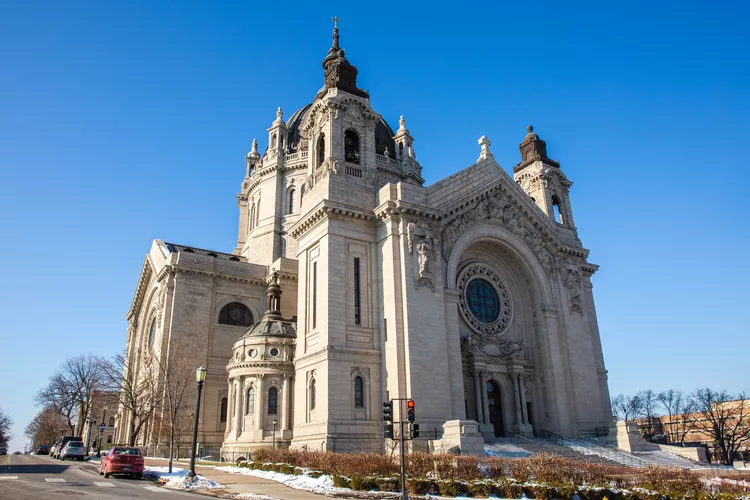Summary
History of the Cathedral
The Cathedral of St. Paul in the city of St. Paul is over 100 years old. The cathedral is the vision of Archbishop John Ireland and architect Emmanuel Louis Masquery, both devoted Catholics.
Construction of the cathedral began in 1907, with the exterior completed by 1914. The interior took longer to finish due to funding constraints, yet the first Mass was celebrated in the partially finished structure on Easter Sunday in 1915.
Masquery passed away in 1917 before he could complete the interior design, followed by Archbishop Ireland, who died a year later. His successors, Archbishop Dowling and Bishop John Murray, oversaw the interior completion, which finished in 1941.
Architecture and Design
The Cathedral of St. Paul is renowned as one of the most beautiful cathedrals in America. Its design is in the Beaux-Arts style, inspired by Renaissance cathedrals in France.
The exterior is constructed from Minnesotan St. Cloud granite. Inside, you’ll find American Travertine from Mankato, Minnesota, with columns crafted from various types of marble.
Atop the Cathedral sits a magnificent 120-foot wide copper dome. A lantern crowning the dome elevates the cathedral’s total height to an impressive 306 feet from its foundation to the top of the lantern.
The interior is equally stunning. As visitors enter the Cathedral, many find themselves awestruck by its grandeur, often stopping to take in the breathtaking sights.
Designed in a Greek cross layout, the open interior reflects Masquery’s vision of unobstructed views for anyone attending Mass.
The soaring interior ceiling reaches 175 feet high at the apex of the 96-foot wide dome. Stained glass windows allow natural light to illuminate the space, complemented by additional windows dotting the walls.
A bronze baldachin, serving as a canopy over the altar, pays tribute to St. Paul.
While the Cathedral’s design pays homage to ancient French architectural styles, it incorporates modern amenities, such as electric lighting and heating. This heating system is particularly valued by attendees during the colder winter months.
Worship at the Cathedral
The Cathedral serves as the Archbishop’s official church and the Mother Church of the Archdiocese of Saint Paul and Minneapolis.
The Basilica of St. Mary in Minneapolis acts as a co-cathedral to St. Paul’s Cathedral.
Masses are held every day in the cathedral, with multiple services on Sundays.
Several chapels are dedicated to the Sacred Heart, Mary, Joseph, and Saint Peter.
The Shrines of the Nations honor saints important to various ethnic groups that contributed to the cathedral’s establishment and the city of St. Paul:
- Saint Anthony of Padua of Italy
- Saint Boniface of Germany
- Saints Cyril and Methodius of the Slavic Nations
- Saint Patrick of Ireland
- Saint John the Baptist of France
- Saint Therese, the Protector of all Missions
Visiting the Cathedral
Located on a prominent bluff overlooking downtown St. Paul, the cathedral is situated at the intersection of Summit Avenue and Selby Avenue.
The cathedral welcomes visitors daily, except on holidays and Holy days. Admission is free, though donations are encouraged.
A parking lot on Selby Avenue provides complimentary parking for cathedral visitors.
At night, the cathedral and its lantern are beautifully illuminated, offering a stunning view from much of downtown St. Paul.
Visitors are welcome to explore the cathedral independently, except during Mass or special events. To enhance your experience, consider joining one of the free guided tours available several times a week.
Location: 239 Selby Avenue, St. Paul, MN 55102
Telephone: 651-228-1766
Visit Lake Harriet for more attractions!




